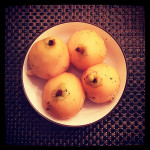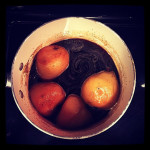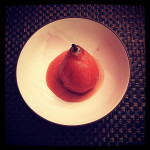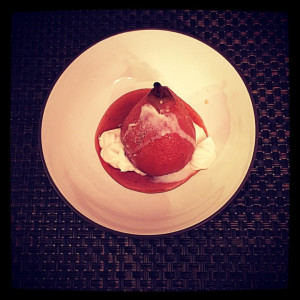History Detective ~ Poached Pears
The Challenge:
History Detective (January 29 – February 11)
For this challenge, you get to be the detective! Either use clues from multiple recipes to make a composite recipe, or choose a very vague recipe and investigate how it was made.
The Recipe:
I completed this challenge at the same time as Challenge #1. It ended up being the dessert for that night.
The main recipe originated from Hannah Glasse’s The Art of Cookery Made Plain and Easy. She calls them Stewed Pears and the recipe reads as follows:

I modified this recipe quite a bit. In fact, I combined two modern recipes, one from Bon Appetit, and the other from Citrus and Candy, to get the desired result I wanted. I discovered both recipes on the research black hole known as Pinterest.
The Date/Year and Region:
Stewed and poached fruit have been around since the times of Ancient Rome. The Art of Cookery dates back to 1774. The Bon Appetit article is from January 2012, and Citrus and Candy’s blog from May 2011.
How Did You Make It:

For this dish, I opted to combine the two modern recipes. Mostly this was because I couldn’t decide which sounded better, as both had aspects I wanted to try.
I started with two cups of water, one cup of sugar, dry Earl Grey tea, two strips of lemon

peel, two tablespoons of cracked cardamom pods. I let those come to a boil until the tea had started to steep before I dropped in the pears. I let them simmer over low heat for…a long time. I honestly don’t know how long they cooked for, as I was trying to multitask at home and forgot they were on the stove. I’d say at least an hour – if not longer – until they turned golden in color. Once that happened, I removed them from the liquid and strained the tea bits out of the syrup and let it cool overnight.

The next day, I put the liquid and another cup of sugar into a saucepan and heat it over medium-low heat until it began to bubble and thicken slightly. I added the dry white wine to the heated liquid and brought it back up to a low simmer, adding a tablespoon of vanilla extract (I love vanilla!). I added the pears and their juice back into the liquid and let it cook down for another hour until the syrup thickened, removing the pears after thirty minutes. The syrup will still be somewhat thin. DO NOT let it reduce any more than that.

Since I already had the crème fraîche from the dinner, I decided to make a topping of it. Thicker than sour cream, and a little less tangy, I still has a nice bite to it. With a spoon, I mixed it with some caster sugar and vanilla extract until it was smooth. I didn’t want it too sweet, so I added it a pinch at a time until it reached the desired sweetness, before spooning it onto the warm pears.
Time to Complete:
I spaced this out over two days, mostly because I started late on the first night. By the time we were done eating steak and potatoes, there was no more room for desert. That being said, the total consecutive time to complete was roughly two hours. Most of the time was spent simmering the liquid down to a syrupy consistency.
Total Cost:
The produce (pears, lemon, and cardamom) came out to $4.50, and the wine was on sale for $7. The crème fraîche did double duty with the steak dinner, so I did not include it in the cost for the dessert. All the other ingredients, I had at home.
How Successful Was It?:
This experiment in cooking turned out really well. With this being at the tail end of the holiday season, I agreed with Karen (the creator of Citrus and Candy) that heavily spiced pears would be too much, especially when acting as a dessert for a rich meal such as the pan-fried steak and potatoes. By poaching them first in tea, then in wine, I was able to get the best of both flavors, while not overpowering the senses with either one. The look of the dish was spectacular, but while cooking and when completed. It was also interesting to see the change in color of the peeled pears as they turned from milky-white to gold and, finally, to a rich mahogany color.
The flavor was different…in a good way! It wasn’t overly rich or heavy like wine soaked fruit tends to be. The dual cooking method – both tea and wine – offered a more subtle and complex flavor profile. The cardamom pods added enough spice to the dish without being overpowering. The tang and coolness of the sweetened crème fraîche was a nice contrast to both the deep color and sweetness of both the warm poached fruit and the syrup.

How Accurate Is It?:
Well, I simmered the fruit in liquid. Does that count as being accurate? Aside from that, I pretty much improvised the entire recipe. That seems to be my MO when cooking, even if I have a detailed recipe – or two!





